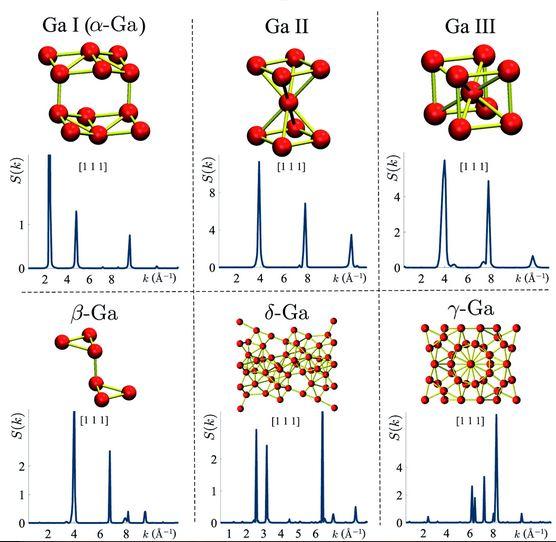Anomalies in structure of polyvalent metal melts explained

Crystal structures and corresponding static structural factors estimated for the direction [111]. Credit: Kazan Federal University
Metals and their alloys are the main structural materials of modern civilization. The properties of metal melts are well studied.
However, according to Anatoly Mokshin, one of the co-authors of the publication, Chair of the Department of Computational Physics at Kazan Federal University, for more than 25 years, scientists from all over the world have been trying to explain experimentally observed structural features of the melts of such metals as gallium, germanium and bismuth.
These features are called “structural anomalies.”
“One of the most popular hypotheses explaining structural anomalies in liquid gallium is that there must be covalently bound pairs of atoms, which are also called Ga2 dimers. But is this really so? Until now, this was unknown.
Experimental physicists from Obninsk, from the Leypunsky Institute of Physics and Power Engineering, approached us with a proposal to tackle this problem. They had obtained a large array of experimental data on neutron diffraction in metal melts, containing information on the internal structure of these melts.
However, they could not explain many of the observed features. As a result of this joint work, it was possible to prove the absence of any stable crystalline domains, as well as of molecule-like Ga2 dimers, in the gallium melt.
It is noteworthy that these results allow us to take a fresh look at the processes associated with the formation of these melts,” Mokshin explained.
The paper was co-authored by Kazan Federal University and RAS Institute of High Pressure Physics and supported by the Russian Science Foundation (project title “Theoretical, simulation and experimental studies of physico-mechanical features of amorphous systems with inhomogeneous local viscoelastic properties”).
Media Contact
All latest news from the category: Life Sciences and Chemistry
Articles and reports from the Life Sciences and chemistry area deal with applied and basic research into modern biology, chemistry and human medicine.
Valuable information can be found on a range of life sciences fields including bacteriology, biochemistry, bionics, bioinformatics, biophysics, biotechnology, genetics, geobotany, human biology, marine biology, microbiology, molecular biology, cellular biology, zoology, bioinorganic chemistry, microchemistry and environmental chemistry.
Newest articles

First-of-its-kind study uses remote sensing to monitor plastic debris in rivers and lakes
Remote sensing creates a cost-effective solution to monitoring plastic pollution. A first-of-its-kind study from researchers at the University of Minnesota Twin Cities shows how remote sensing can help monitor and…

Laser-based artificial neuron mimics nerve cell functions at lightning speed
With a processing speed a billion times faster than nature, chip-based laser neuron could help advance AI tasks such as pattern recognition and sequence prediction. Researchers have developed a laser-based…

Optimising the processing of plastic waste
Just one look in the yellow bin reveals a colourful jumble of different types of plastic. However, the purer and more uniform plastic waste is, the easier it is to…



